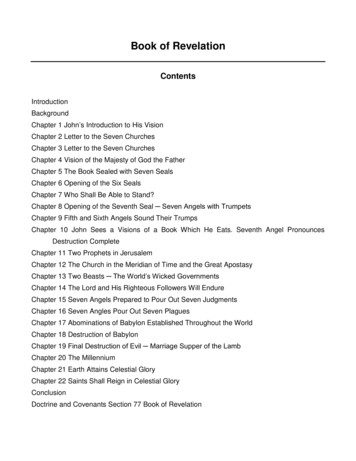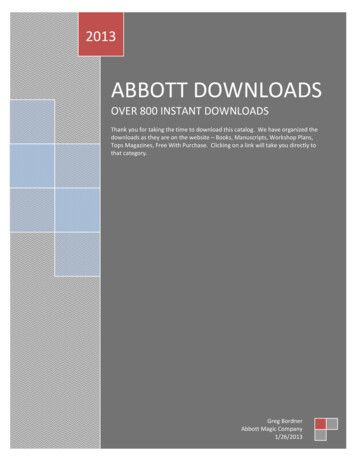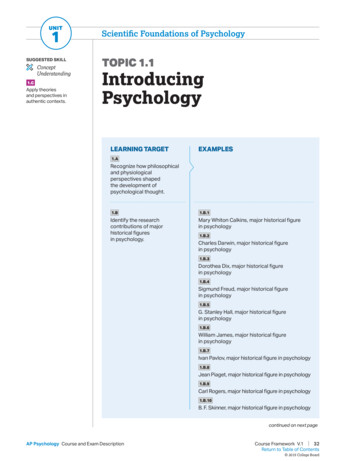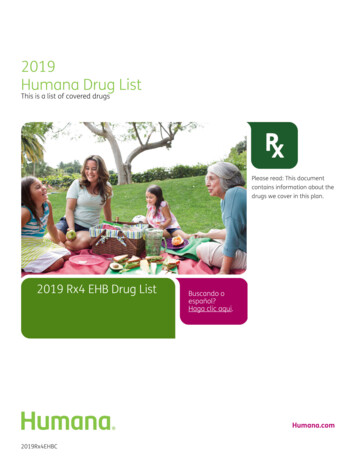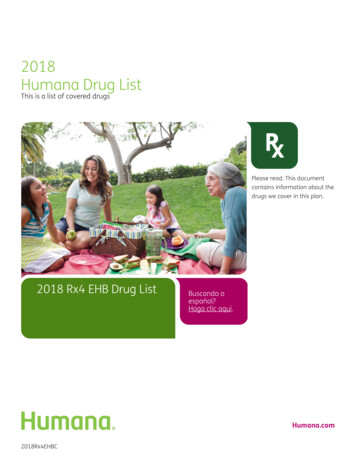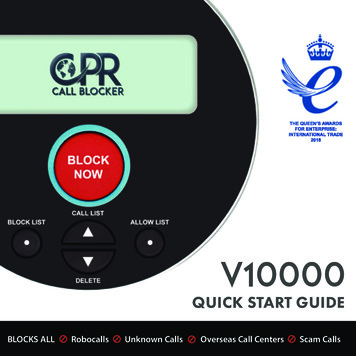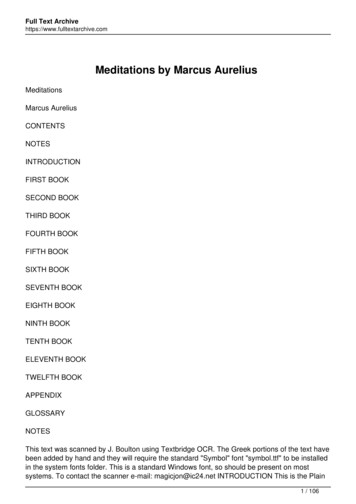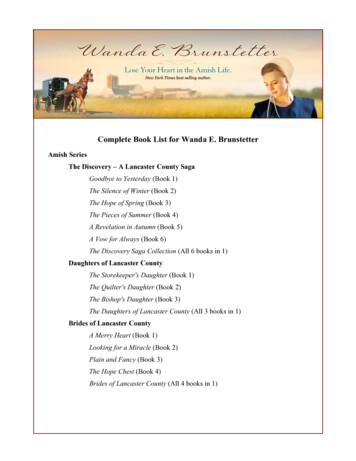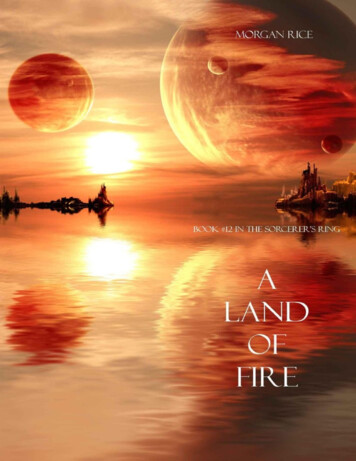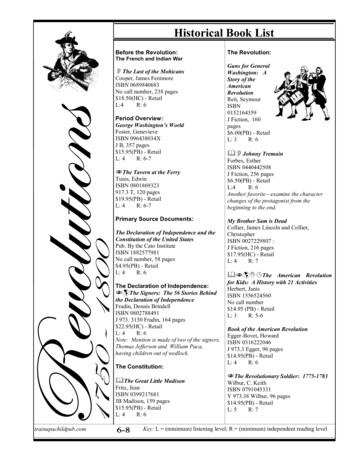
Transcription
Historical Book ListBefore the Revolution:The French and Indian War The Last of the MohicansCooper, James FenimoreISBN 0689840683No call number, 238 pages 18.50(HC) - RetailL:4R: 6Period Overview:George Washington’s WorldFoster, GenevieveISBN 096438034XJ B, 357 pages 15.95(PB) - RetailL: 4R: 6-7 The Tavern at the FerryTunis, EdwinISBN 0801869323917.3 T, 120 pages 19.95(PB) - RetailL: 4R: 6-7Primary Source Documents:The Declaration of Independence and theConstitution of the United StatesPub. By the Cato InstituteISBN 1882577981No call number, 58 pages 4.95(PB) - RetailL: 4R: 6The Declaration of Independence: The Signers: The 56 Stories Behindthe Declaration of IndependenceFradin, Dennis BrindellISBN 0802788491J 973. 3130 Fradin, 164 pages 22.95(HC) - RetailL: 4R: 6Note: Mention is made of two of the signers,Thomas Jefferson and William Paca,having children out of wedlock.The Constitution: The Great Little MadisonFritz, JeanISBN 0399217681JB Madison, 159 pages 15.95(PB) - RetailL: 4R: 6trainupachildpub.comThe Revolution:Guns for GeneralWashington: AStory of theAmericanRevolutionReit, SeymourISBN0152164359J Fiction, 160pages 6.00(PB) - RetailL: 3R: 6 Johnny TremainForbes, EstherISBN 0440442508J Fiction, 256 pages 6.50(PB) - RetailL:4R: 6Another favorite—examine the characterchanges of the protagonist from thebeginning to the end.My Brother Sam is DeadCollier, James Lincoln and Collier,ChristopherISBN 0027229807 :J Fiction, 216 pages 17.95(HC) - RetailL: 4R: 7 The American Revolutionfor Kids: A History with 21 ActivitiesHerbert, JanisISBN 1556524560No call number 14.95 (PB) - RetailL: 3R: 5-6Book of the American RevolutionEgger-Bovet, HowardISBN 0316222046J 973.3 Egger, 96 pages 14.95(PB) - RetailL: 4R: 6 The Revolutionary Soldier: 1775-1783Wilbur, C. KeithISBN 0791045331Y 973.38 Wilbur, 96 pages 14.95(PB) - RetailL: 5R: 7Key: L (minimum) listening level; R (minimum)independent reading levelinfodesk@trainupachildpub.com
Historical Book List Revolutionary Medicine:1700-1800Wilbur, M.D., C. KeithISBN 0791045323Y 973.375 Wilbur, 80 pages 14.95(PB) - RetailL: 5R: 7Fascinating for those studentsinterested in the medical field, but maybe a little graphic for some.Patriot Biographies: America’s Paul RevereForbes, EstherISBN 0395249074JB Revere, 46 pages 5.95(PB) - RetailL: 2R: 5-6A Young PatriotMurphy, JimISBN 0395900190J 973.3, 102 pages 7.95 (PB) - RetailL: 3R: 5-6 John and Abigail AdamsSt. George, JudithISBN 0823415716JB Adams, 147 pages 22.95(HC) - RetailL: 5R: 7 Thomas Jefferson: Architect ofDemocracySeverance, John B.ISBN 0395845130JB Jefferson, 192 pages 18.00(HC) - RetailL: 5R: 7Give Me Liberty: the UncompromisingStatesmanship of Patrick HenryVaughn, DavidISBN 1888952229B Henry, 285 pages 14.95(PB) - RetailR: 8 Samuel Adams: The Father ofAmerican IndependenceFradin, DennisISBN 0395825105YB Adams, 192 pages 18.00(HC) - Retailtrainupachildpub.comL: 4R: 6-7The Swamp FoxBrown, Marion MarshASIN 0664320716J Biography, 185 pagesOOPL: 3R: 5-6The Many Lives of Benjamin FranklinOsborne, Mary PopeASIN 0803706790JB Franklin, 127 pagesOOPL: 2R: 5-6Note: On page 51, the author mentionshe did not have a “formal weddingceremony,” but just informallyconsidered himself married. Whetheryou read this biography or another onFranklin, we suggest you have a candiddiscussion with your students aboutFranklin not being a Christian.Although he believed in God, heprobably shared more of the deistphilosophy of many at the time. Despitethe fact he wasn’t a believer, God gavehim extraordinary gifts and He usedFranklin to carry out His purposes.Poetry/Fine ArtsAmerica's Old Masters: BenjaminWest, John Singleton Copley, CharlesWillson Peale and Gilbert StuartFlexner, James ThomasISBN 048627957X759.13 12.95(PB) - RetailConstable’s EnglandReynolds, GrahamISBN 048627957X759.2 12.95(PB) - RetailMasterpieces of American Painting inthe Metropolitan MuseumSalinger, MargarettaASIN 0870994727759.13 OOPYoung America: Treasures from theSmithsonian American Art MuseumPastan, AmyISBN 0823001938759.13074 19.95(PB) - RetailThe French Revolution:The Scarlet PimpernelOrczy, Baroness EmmuskaISBN 0451527623J FictionChapter book, 223 pages 4.95(PB) - RetailL: 5R: 7Other Resources: Uncle Sam & Old Glory : Symbolsof AmericaWest, Jean and DelnoISBN 0689820437J 929.92, 40 pages 17.00(HC) - RetailL: 2R: 5 and upWhile suitable for young children, itwill also benefit older students.Music of the American Revolution:The Birth of LibertyASIN B0000030FQNew World Records 17.99(CD) - RetailLiberty Tree: Early American Music1776 - 1861ASIN B00000AGN3 16.98(CD) - RetailThis may be used throughout all of theearly American units. What You ShouldKnow about theAmerican FlagWilliams, Jr., Earl P.infodesk@trainupachildpub.com
ScienceHuman Body:Use pp. 92-95 for this topic.Science ScopeStout, KathrynNo ISBNNo call number 15.00(PB) - Retailwww.designastudy.comUse pp. 56-64 for this topic.The Human Body for Every KidVanCleave, JaniceISBN 0471024082J 612.078 12.95(PB) - RetailUse experiments #17-23 for this unit.Biology for Every KidVanCleave, JaniceISBN 0471503819J 574 12.95(PB) - RetailUse experiments # 88-101 for this topic.Science Projects About the HumanBodyGardner, RobertISBNY612.0078 20.95(HC) - RetailMachines:Science ScopeStout, KathrynNo ISBNNo call number 15.00(PB) - Retailwww.designastudy.comJanice VanCleave's MachinesVanCleave, JaniceISBN 0471571083J 507.8 10.95(PB) - Retail Gear Up!: Marvelous MachineProjectsGood, KeithISBN 0822535661J 621.811 21.27(HC) - RetailHow The Future Began: MachinesGifford, CliveISBN 0753451883No call number 15.95(HC) - RetailJanice VanCleave's Physics for EveryKidVanCleave, JaniceISBN 0471525057No call number 12.95(PB) - Retail Science Experiments with Sound &MusicLevine, SharISBN 0806976977No call number 10.95(PB) - Retail The Optics Book: Fun ExperimentsWith Light, Vision & ColorLevine, SharISBN 080699942XY 535 10.95(PB) - RetailSound, Heat and Light:Science ScopeStout, KathrynNo ISBNNo call number 15.00(PB) - Retailwww.designastudy.comUse pp. 98-100, 102 for this topic.Science ActivitiesHuman Body LapbookCreate a lapbook that includes thesystems of the human body. Do a minibook on each system, include picturesfrom the internet or other books youhave read from the science list. Alsoput in any lab results from human bodyexperiments you have done from thebooks in the science list.trainupachildpub.comSimple Machines DisplayBuild or find examples of simplemachines and create a display to sharewith friends and family. Label each ofthe machines and write or explainorally how they contribute to things weuse each day.Sound and Light ExperimentsDo experiments from Sharon Levine’sbooks (see Science book list). Be sureto keep an experiment journal thatincludes: list of materials, hypothesis,steps of the process, data, and resultsfor each experiment.infodesk@trainupachildpub.com
Project IdeasArts and CraftsIdeas for Mini-books and Lapbooks 1. The American Revolution for Kids: A History with 21Activities (See page one of this unit.) Make a fringed hunting shirt Design a tricorn hat Reenact the Battle of Cowpens Research the history of political cartoons and2. Book of the American Revolution(See page one of this unit .) Build a model fort, p. 52 Read about spies during the Revolution, and play thegame British Spy, on pages 40-41. With your Train up a Child Publishing co-op group,practice and perform the play, The Boston Massacre, onpages 28-31. 3. After researching particular battles, make a model of one.If you are doing it on a large scale, use cardboard boxes. Ifspace is limited, use plaster of Paris, clay or other modelingmaterial, popsicle sticks, etc. Using your model, demonstratewhat happened during the battle and the outcome. Explain toyour family and friends or to your homeschooling supportgroup.Map Ideas Writing and Ideas for furtherresearch 1. Using an historical atlas, make a salt or cookie mapof the thirteen colonies as of 1763. Include andlabel each colony, major cities and all majorgeographical landforms.2. Using an atlas, make a large map of thecolonies with sidewalk chalk. Label the colonies.Using old game parts, construct a Twister game to play with your friends and to help youlearn the locations of the colonies.3. Make a map of and label major Revolutionary Warbattles. Include Battles of Lexington andConcord, Bunker Hill, Long Island, WhitePlains, Trenton, Princeton,Brandywine, Germantown andMonmouth.trainupachildpub.comgather samples of political cartoons madeduring the Revolutionary War. Create alapbook of these cartoons, along withwritten summaries about their meanings andsignificance.Choose a Revolutionary personality and createlapbook about his or her life. Includedownloaded images: a portrait, pictures offamily, home, maps, etc. Also include writtensummaries of this person’s contribution tothe war effort (for either side) or to the time heor she lived.Study the differences between the Revolutionary Warand the French Revolution. Make a lapbook on thecomparisons and the contrasts. Research and write an essay about the first publishedblack poet in America, Phillis Wheatley.People during the 1700’s often occupied themselves withcreating and trying to figure out each other’s rebuses.With your siblings or Train up a Child Publishing coopgroup, try your hand at making up your own!Create a graphic timeline of either the American orFrench Revolution.Research this time period and write an essay about theRevolutions of thought and technology during this unit,such as the Agricultural revolution. What other“revolutions” can you find?Research the French Revolution. Take notes asto the similarities and differences between it andthe American Revolution. Did it succeed or fail?Why or why not? 2003 Train up a Child Publishing1342 Oak Mill CourtMt. Pleasant, SC 29466infodesk@trainupachildpub.com
Revolutions OverviewThis overview begins not with political revolutions, but with revolutions of thought. Greatstrides in science, technology and industry revolutionized the way people lived andworked. Art and music flourished in some areas, while political revolutions broughtbloodshed in others.PmechanizationAsThe Agricultural and Early Industrialincreased,large mills and factories were built andRevolutions in Europerior to this time, people grewpeoplebeganleavingtheirruralenough crops for their ownsurroundings to take jobs in towns andfamilies. When they neededcities. England had an abundance of landsomething, it was made by hand or in athat was not devastated by war, unlikecraftsman’s small shop. In the 1700s, asmuch of the rest of Europe, so the earlya result of the “Age of Reason,” scienceIndustrial Revolution began there withand technology began to be applied tothe textile industry.agriculture and industry, which radicallyinfluencedhowpeoplelivedThe American Revolution – The Birthandworked. Enclosing fields into parcelsof Americanthat were easier to work, rotating crops,While England was busy fighting onand learning to breed animals forseveral European fronts, her originaladvantageous characteristics, allowedthirteen colonies in North America grewmore productive farming that could feedincreasingly independent. After almostnot just one family, but enough that theonesurplusothers.hardworking pioneers had carved outInventions such as the steam enginelives for themselves and their families,(1712), (thread-) spinning jenny (1764),and in doing so, had forged a nationaland the cotton gin (1794), meant thatidentity, separate from the land of theirtextiles could be rapidly processed s,created by machines rather than by hand,During the early colonial years,one item at a time, as had always beenEngland had been more preoccupieddone before.with conflicts on her own soil, both incivil war and conflict with other nations1 2016 Train up a Child Publishing
who also wanted to dominate Europe,dutiesthan with the governing of her Americanleaders, such as the unpopular Molassescolonies. The Seven Years’ War, fromAct and Sugar Act, the cry went out ithoutconsultingcolonialrepresentationareuneasy balance of power in Europe andtyranny!”proved England the victor over France inEngland was still their king, but as theyThe Frenchhad no elected officials representingand Indian War, part of the Seventhem in Parliament, it had no right toYear’s War that was fought on Americandemand anything from them.soil, was fought by the British and theof course, heartily disagreed.colonists against the French.Nativeattempting to handle the colonies with aAmericans actually fought on both sidesfirm hand, other unpopular rulings wereThe Peace of Paris, inestablished: the Royal Proclamation of1763, ended the conflict and resulted in1763 reserved all of the newly-gainedEngland gaining control of FrenchFrench land for the Native Americans,holdings in Canada and southwest intothereby putting and immediate stop to allthe Ohio Valley.thirteen colonies’ claims for additionalNorth America as well.of the war.Colonials felt the King ofEngland,InEngland, although pleased at theland to settle. To the crowded colonists,victory, recognized the need for morethis showed an overbearing disregard forincome to rebuild its sagging economywhat they considered a basic right.after years of expensive war.WhyAdditional unpopular measures were theshouldn’t the thirteen colonies help footStamp Act, requiring revenue stamps bethe bill for their own defense? Englandplacedwas going to have to strengthen itslicenses, etc., and the Quartering Act,administration in America in order todemanding the colonists provide bothderive more revenue from the colonies.housing and provisions, at their ownHowever, the colonies had been growingexpense, to British troops supposedlyand prospering during these colonialthere for the colonist’s protection.onnewspapers,pamphlets,years, and all had set up some form ofThe presence of unwanted Britishself-governing body. When the Englishtroops in Boston eventually caused theParliament began levying taxes andfirst act of violence. 2016 Train up a Child Publishing2What began as
citizen’s heckling or snowballing ofEngland responded to the Bostonsoldiers ended with someone giving anTeaorder to “Fire!” -resulting in three deadrestrictivecivilians.“BostonIntolerable Acts, one of which was toMassacre,” this incident was effectivelyclose the Boston Harbor until the costused by protesters to fan the flame offor the dumped tea was paid. At thediscontent.escalated,urging of the Virginia’s House ofcolonists found themselves somewhatBurgesses, Americans responded bydivided.At first only a fairly smallholding the first Continental Congressnumberofsoughtin Philadelphia in the fall of 1774.independence. Led by Massachusetts’sRepresentatives attended from all of theSamuel Adams, a group of radicalscolonies except for Georgia.called the “Sons of Liberty” wasCongress attempted to restore llyThis was the group asbytheThelistingeventually dressed up as Mohawkcolonial grievances and sending them byIndians and dumped a shipload ofcourier to King George III.English Tea in Boston’s harbor in 1773,further decided to boycott trade fromthe event known as the “Boston TeaEngland for the time being and toParty.”convene a second Continental CongressAdams and others busily wroteIt wasthe following year if the grievances stillnewspaper articles and made speeches atexisted.town meetings, trying to encourageAs tensions heightened, colonials in thecitizens to permanently break withareas surrounding Boston began to readyEngland. An English philosopher andthemselves to fight, quietly gatheringjournalist, Thomas Paine, aiding thearms and ammunition.revolutionaries,aBritish General Thomas Gage learned“Commonof these munitions from his spies, and onSense,” emotionally and effectivelythe night of April 18, 1775, Gage andpresenting the case for independence700 of his soldiers marched 21 milesfrom Britain.from Boston to Concord in order stroy the stored munitions and capture3 2016 Train up a Child Publishing
down an upstart colony’s uprising intwo known rebel agitators, Sam AdamsandJohnHancock,effectivelyMassachusetts produced the oppositelaunching the American Revolution. Inreaction, generating support for militaryorder to warn the militiamen, theaction against England in other coloniessilversmithDawesandPaulRevere,Williamup and down the eastern seaboard.Dr.SamuelPrescottEvents occurred quickly at this point.undertookthatfamousrideonHaving received reinforcements, Generalhorseback.When the British troopsGage moved to occupy the heightsarrived in Lexington on the morning ofaroundthe 19th, they found 38 militiamenopposition already there and dug in. Thewaiting for them. The first shots of themisnamed Battle of Bunker Hill, whichwar were fired, and eight Americanswas really fought on nearby Breed’sdied. After the colonial supplies that hadHill, resulted in many deaths on bothnot been moved were destroyed, thesides and served to prove to the BritishBritish began the long return trip tojust how serious the colonial rebels wereBoston.about not submitting to Britain’s heavy-They were attacked by moreBoston,colonists who easily thinned Britishhanded authority.ranks because of their ring their marchCongress convened in May of 1775, thishome, about 250 “redcoats” lost theirtime with representatives of all thirteenlives, compared with about 90 deaths ofcolonies. Even now there were distinctAmericandifferencesbright red were committed to be “ready in aseparation from England.minute” to defend their country. ThusMassachusetts offered it’s militia as thebegan the colonists’ fight for freedom.basis for a Continental Army to beWhen King George in EnglandheadedbyAlthoughGeneralGeorgeheard General Gage’s account of thisWashington, a more moderate groupincident, he furiously remarked thatworked toward appeasement.America “must be a colony of EnglandDickinson drafted the Olive Branchor treated as an enemy.” Britain’s desirePetition, which professed loyalty to Kingto make a statement by quickly puttingGeorge and asked that all bloodshed and 2016 Train up a Child PublishingThis is the end of the Sample.the RevolutionsTeacher's Overview goes on several morepages.4John
VanCleave, Janice ISBN 0471503819 J 574 12.95(PB) - Retail Use experiments # 88-101 for this topic. Science Projects About the Human Body Gardner, Robert ISBN Y612.0078 20.95(HC) - Retail Machines: Science Scope Stout, Kathryn No ISBN No call number 15.00(PB) - Retail www.designastudy.com Use pp. 92-95 for this topic. Janice VanCleave's Machines

